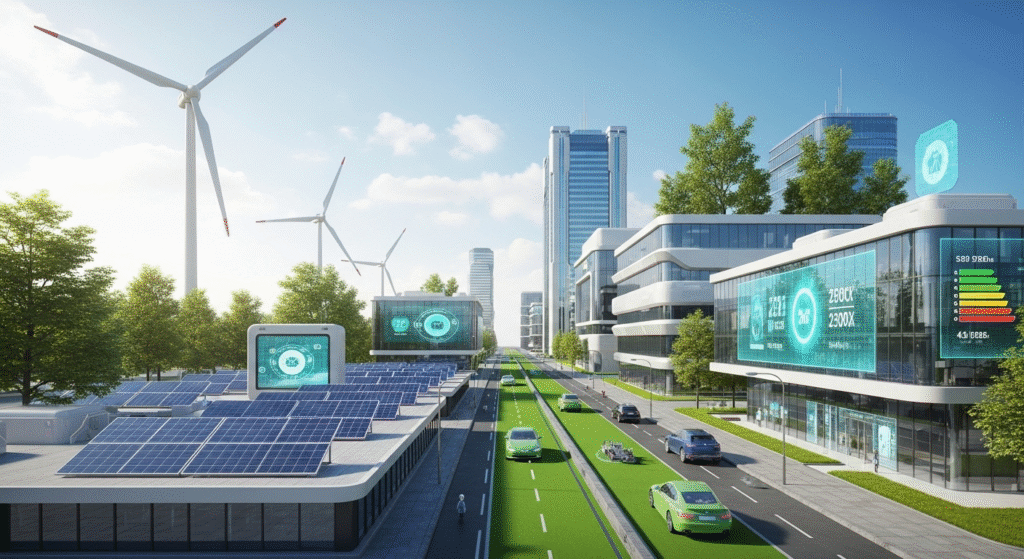Introduction: The Rise of Sustainable Technology
In an age of rapid technological progress, sustainability has become more than just a buzzword — it’s a necessity for the planet’s survival. From smart homes that reduce energy waste to massive renewable power grids, green technology (or “clean tech”) is reshaping how we live, work, and consume resources.
The global push for sustainability has encouraged innovators and startups to create solutions that reduce carbon footprints, improve efficiency, and make renewable energy accessible to everyone.
🌞 What Is Green Technology (GreenTech)?
Green technology, also called eco-tech or clean technology, refers to innovations designed to minimize environmental impact and promote resource efficiency. These technologies focus on:
-
Reducing greenhouse gas emissions
-
Conserving natural resources
-
Improving energy efficiency
-
Supporting sustainable economic growth
Examples include solar panels, wind turbines, electric vehicles (EVs), energy-efficient appliances, and AI-driven climate models.
⚡ Renewable Energy Innovations Driving the Future
1. Solar Power 2.0
Traditional solar panels are evolving with perovskite solar cells, which are lighter, more flexible, and more efficient. Companies like SunPower and First Solar are already testing these next-gen panels to improve energy output and lower production costs.
2. Offshore Wind Farms
Modern wind turbines are larger, quieter, and more efficient. Offshore farms like Dogger Bank (UK) are now producing gigawatts of clean energy, powering millions of homes without occupying land space.
3. Hydrogen Energy
Hydrogen fuel cells are becoming a major player in the renewable energy sector. Green hydrogen, produced using renewable electricity, offers a sustainable alternative for heavy industries and long-distance transport.
4. Energy Storage Solutions
Innovations in battery technology, such as solid-state batteries and recyclable lithium-ion cells, are solving one of the biggest challenges in renewable energy — storage stability and grid balance.
🏠 Climate-Friendly Smart Devices for Everyday Living
Sustainability isn’t limited to large-scale energy systems — it starts at home.
1. Smart Thermostats
Devices like Google Nest and Ecobee learn your habits and automatically adjust temperatures, saving up to 20% on energy bills.
2. Solar-Powered Gadgets
From solar chargers to solar lanterns, small yet powerful solar tech devices are making off-grid living more practical and eco-friendly.
3. Smart Lighting Systems
LED smart bulbs use 75% less energy and can be automated with motion sensors or voice assistants, reducing electricity waste.
4. Eco-Friendly Appliances
Brands like LG and Samsung now offer energy-efficient refrigerators, washing machines, and air conditioners equipped with AI sensors that optimize performance and power use.
🌱 The Role of Artificial Intelligence in Sustainability
AI and machine learning are accelerating the fight against climate change by improving energy efficiency and predicting environmental patterns.
-
AI-driven energy grids can balance power loads and reduce waste.
-
Smart agriculture systems use IoT sensors to monitor soil health, reducing water and pesticide use.
-
Climate modeling with AI helps scientists forecast extreme weather and develop adaptive strategies.
🌐 The Rise of Smart Cities
Urban areas are adopting sustainable technologies to reduce pollution and resource waste. Smart cities integrate IoT devices, renewable energy systems, and data-driven planning for:
-
Efficient public transportation (EV buses, shared mobility apps)
-
Smart waste management (AI-based sorting systems)
-
Green architecture (energy-efficient building materials, rooftop solar)
Cities like Singapore, Copenhagen, and Amsterdam are leading examples of tech-powered sustainability in action.
💡 Challenges and the Road Ahead
While green tech is promising, it faces challenges such as:
-
High initial costs for clean energy infrastructure
-
Limited recycling of electronic components
-
Uneven access to renewable energy in developing nations
However, with continuous innovation, government incentives, and public awareness, sustainable technology is becoming more affordable and mainstream.
🔋 Conclusion: Building a Smarter, Greener Tomorrow
The fusion of sustainability and technology is not just transforming industries — it’s redefining our future. Every innovation, from AI-driven climate systems to eco-smart homes, brings us closer to a cleaner, more resilient planet.
By adopting green tech solutions and supporting renewable energy innovations, we can all play a part in shaping a sustainable digital age.



